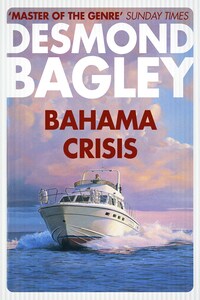HarperCollinsPublishers Ltd 1 London Bridge Street London SE1 9GF
www.harpercollins.co.uk
First published in Great Britain by Collins 1980
Copyright © Brockhurst Publications 1980
Cover layout design Richard Augustus © HarperCollinsPublishers Ltd 2017
Desmond Bagley asserts the moral right to be identified as the author of this work.
A catalogue copy of this book is available from the British Library.
This novel is entirely a work of fiction. The names, characters and incidents portrayed in it are the work of the author’s imagination. Any resemblance to actual persons, living or dead, events or localities is entirely coincidental.
All rights reserved under International and Pan-American Copyright Conventions. By payment of the required fees, you have been granted the non-exclusive, non-transferable right to access and read the text of this ebook on screen. No part of this text may be reproduced, transmitted, down-loaded, decompiled, reverse engineered, or stored in or introduced into any information storage and retrieval system, in any form or by any means, whether electronic or mechanical, now known or hereinafter invented, without the express written permission of HarperCollins ebooks
Source ISBN: 9780008211332
Ebook Edition © August 2017 ISBN: 9780008211349 Version: 2017-07-05
My name is Tom Mangan and I am a Bahamian – a white Bahamian. This caused some comment when I was up at Cambridge; it is surprising how ill-informed even supposedly educated people can be about my home islands. I was told that I could not be a Bahamian because Bahamians are black; that the Bahamas are in the Caribbean, which they are not; and many confused the Bahamas with Bermuda or even Barbados. For these reasons and because an understanding of the geographical and political nature of the Bahamas is essential to my story it seems to me that I must describe them and also give a brief account of my family involvement.
The Bahamas are a chain of islands beginning about fifty miles off the coast of Florida and sweeping in an arc 500 miles to the south-east to a similar distance off the coast of Cuba. They consist of 700 islands (called cays locally, and pronounced ‘keys’) and about 2000 lesser rocks. The name is derived from the Spanish baja mar which means ‘shallow sea’.
I am descended from one of the Loyalists who fought in the American War of Independence. Surprisingly few people are aware that more Americans fought in that war on the side of the British than ever did under the rebel generals, and that the war was lost more by the incompetence of the British than any superiority on the part of George Washington. Be that as it may, the war was lost by the British, and the American nation was born.
Life in the new United States was not comfortable for the erstwhile Loyalists. Reviled by their compatriots and abandoned by the British, many thought it prudent to leave, the northerners going mostly to Nova Scotia and the southerners to the Bahamas or to the sugar islands in the Caribbean beyond Cuba. So it was that in 1784 John Henry Mangan elected to settle with his family on the island of Abaco in the Bahamas.
There was not much to Abaco. Shaped something like a boomerang, Great and Little Abaco Islands stretch for about 130 miles surrounded by a cluster of lesser cays. Most of these smaller cays are of coral, but Abaco itself is of limestone and covered with thick, almost impenetrable, tropical bush. Sir Guy Carleton intended to settle 1500 Loyalists on Abaco, but they were a footloose and fractious crowd and not many stayed. By 1788 the total population was about 400, half of whom were black slaves.
It is not hard to see why Carleton’s project collapsed. Abaco, like the rest of the Bahamian islands, has a thin, infertile soil, a natural drawback which has plagued the Bahamas throughout their history. Many cash crops have been tried – tomatoes, pineapples, sugar, sisal, cotton – but all have failed as the fertility of the soil became exhausted. It is not by chance that three settlements in the Bahamas are called Hard Bargain.
Still, a man could survive if he did not expect too much; there were fish in the sea, and one could grow enough food for one’s immediate family. Timber was readily available for building, the limestone was easily quarried, and palmetto leaf thatch made a good waterproof roof. John Henry Mangan not only survived but managed to flourish, along with the Sands, the Lowes, the Roberts and other Loyalist families whose names are still common on Abaco today.
The Mangans are a thin line because, possibly due to a genetic defect, they tend to run to girls like the Dutch royal family. Thus they did not grow like a tree with many branches but in a straight line. I am the last of the male Mangans and, as far as I know, there are no others of that name in the Islands.














